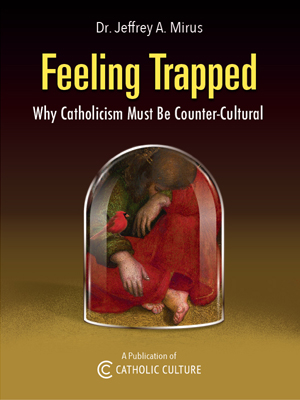The surprising outcome of Bishop Lahey's trial
By Phil Lawler ( bio - articles - email ) | May 06, 2011
Most of us were caught off guard on Wednesday, May 4, when Bishop Raymond Lahey pleaded guilty to child-pornography charges and announced that he wanted to begin his prison term (a 1-year minimum) immediately.
But some people were evidently not surprised. And therein lies a tale.
In the 20 months since he was apprehended at the Ottawa airport, carrying a laptop computer loaded with files of pornography, Bishop Lahey had not given any indication that he would acknowledge his guilt. His lawyer worked the case slowly through the Canadian legal system, accepting several postponements. The guilty plea came only as the case went to trial. If Bishop Lahey wanted to plead guilty—if he was anxious to begin serving his sentence immediately!--couldn’t that have been arranged months ago?
So it was surprising when the bishop entered his guilty plea. Yet within hours both the Canadian Conference of Catholic Bishops (CCCB) and the Vatican press office had issued formal statements responding to the news of the bishop’s plea. The CCCB statement was not particularly remarkable; it seems reasonable to assume that Bishop Lahey would have shared his thoughts with at least some of his old Canadian colleagues, and the CCCB would have been on high alert, ready to respond, when the trial began. But the quick response from the Vatican was a different matter entirely.
When news breaks unexpectedly, the response from the Vatican press office is typically slow, painful, and fumbling. Yet in this case, despite the adverse time differential between Ottawa and Rome, the Vatican reaction was quick, concise, and directly on target. The statement issued by Father Federico Lombardi condemned pornography and the exploitation of children, then introduced an interesting new note:
“The Holy See will continue to follow the canonical procedures in effect for such cases, which will result in the imposition of the appropriate disciplinary or penal measures.”
It is possible that Father Lombardi could have dashed off an excellent short statement condemning child pornography. But the director of the Vatican press office, acting on his own authority, could not have made the decision to reveal that Bishop Lahey still faces further disciplinary action by the Church. Father Lombardi would not have made that disclosure unless he had consulted with higher Vatican officials about the case. Thus it appears that the Holy See was not caught off guard by Bishop Lahey’s guilty plea: that Vatican officials had time to plan their strategy before the trial, and craft a careful response.
Why did Bishop Lahey plead guilty, after giving no previous indications that he planned to do so? Did the prosecutor drive home the message that a public trial would expose him to further disgrace? Did his brother bishops in Canada, or officials at the Vatican put pressure on him? We do not know. But the available facts certainly do support the theory that someone, somehow, made a very persuasive case for a guilty plea. It is worth noticing that when the plea was entered, neither the Canadian bishops’ conference nor the Vatican acted at all surprised.
One other question can be asked and answered quickly. Why did the Vatican and the CCCB wait until after the guilty plea before issuing their public statements? CCCB sources explained that they did not want to make statements that could jeopardize the outcome of the criminal trial. By accepting his hasty resignation, the Vatican had already shown its hand, indicating that Rome did not see Bishop Lahey as the innocent victim of a false accusation. Church leaders have been biding their time, waiting for Canadian prosecutors to wrap up their work. But the Vatican, too, has evidently been building a canonical case against a bishop who has brought severe scandal upon the Church.
Three times in the past 7 months, the Vatican has forced the resignation of an erring bishop. This aggressive new approach to episcopal discipline has been evident since Cardinal Marc Ouellet became prefect of the Congregation for Bishops. (It may be significant that Cardinal Ouellet is a Canadian, who would have been quite familiar with Bishop Lahey’s case.) In this case, the bishop resigned voluntarily. But the events of this week—the surprise guilty plea and the quick response from Rome—suggest that the Vatican had taken a tough line in the Lahey case, too.
All comments are moderated. To lighten our editing burden, only current donors are allowed to Sound Off. If you are a current donor, log in to see the comment form; otherwise please support our work, and Sound Off!
-
Posted by: phil L -
May. 09, 2011 3:20 PM ET USA
Jackist, there is no procedure. The Pope has sole authority and discretion over how the process is conducted. In this case, apparently, the process took several years.
-
Posted by: jackist7902 -
May. 09, 2011 2:40 PM ET USA
Are there canonical procedures that must be followed before the Pope removes a bishop from office? If so, how long does the process take, and what does that tell us about when the process to remove the recent bishops began?
-
Posted by: koinonia -
May. 06, 2011 8:55 PM ET USA
It is one thing to have a mistress on the side- certainly mortally sinful and a tremendous scandal to the faithful- as a prince of the Church, but prelates in possession of child pornography and molesting children in one's own family and then defending it in public? Really??!! It's been a bad month of May for the episcopate. This "aggressive new approach" is apparently long overdue, and it is the least that can be expected by the faithful in dealing with these __________ (fill in the blank).









